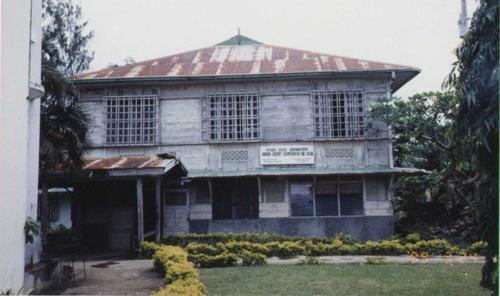BILIRAN (TOWN) PHOTO GALLERY
A picture paints a thousand words, went the lyrics of a song adapted
from a Chinese proverb. Thus this gallery of self-telling photographs,
mostly of landmarks and buildings described in two books
written by Mr. Kennosuke Nakajima, a radio operator assigned in 1944
at the headquarters of a company of Japanese soldiers in Biliran town.
The two books, Leyte Island: Wandering Between Life and Death
(1986) and Leyte's Songs for the Dead (1988), immortalized the
peaceful war years in Biliran town.

The Biliran Bridge, gateway to Biliran Province from Leyte, spans a very narrow channel. Photographed from the wharf of Biliran town, with the mountains north of Capoocan and Leyte-Leyte in the background. This picture was chosen Photograph of the Day for November 20, 1999 of the Tanikalang Ginto website.

View of Biliran poblacion and mountains from the town wharf. The wharf, now about a kilometer long, was much shorter during the war years. It did not reach down the level of the present breakwater (to the right of the picture in the foreground).

The town hall of Biliran, headquarters of the 10th Company, 3rd Battalion, 9th Infantry Regiment of the Japanese Imperial Army during the war. The original framework of the building has been essentially retained. This photograph was taken from the Biliran bus terminal, which used to be the site of a school building that was also confiscated for use by the Japanese soldiers stationed in Biliran town.

The church (left) and the old convent (right) of Biliran photographed from across the town plaza, a drill and recreation area of the Japanese soldiers during the war.

This old Spanish house above faces the town plaza from the right of the above photograph.

Close-up photograph of the old convent frequently visited by Mr. Kennosuke Nakajima during his tour of duty in Biliran town in 1944. The picture was taken from the front of the church.